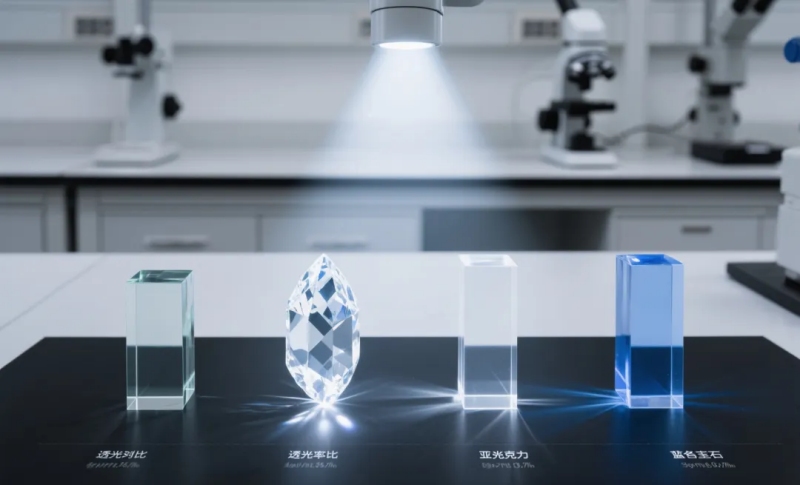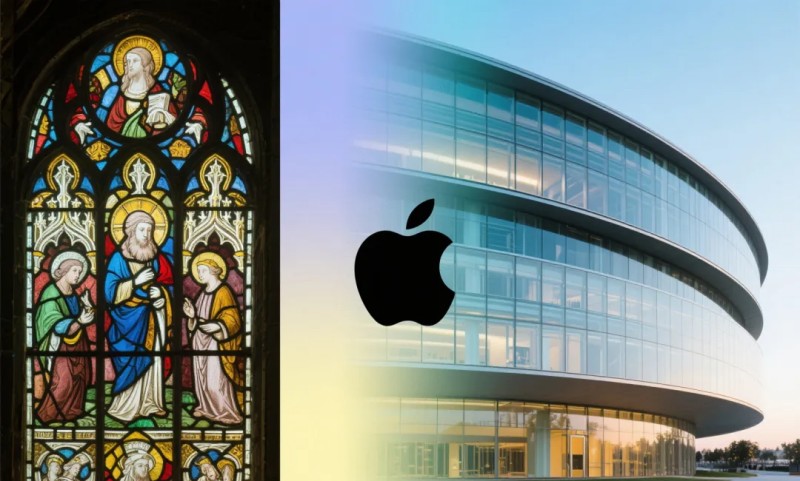
Every morning, we push open the windows and the sun shines through the glass into the room; On the desk, the water in the transparent glass refracts light and shadow; In the museum, thousand-year-old cultural relics are quietly displayed in glass display cases...... Glass, a seemingly ordinary material, has changed human civilization with its "transparent" properties. But have you ever wondered: why does glass allow light to pass through, but wood and stone cannot? Today, we will uncover the scientific code of glass "light transmission" from microscopic particles to the laws of the universe.

First, ask a question: What exactly is "transparency"?
In physics, the essence of "transparency" is the ability of light to pass through matter almost unobstructed. The world we see is essentially the result of light reflecting, refracting, or absorbing on the surface of objects and entering the eye. Like what:
- Opaque objects (such as wood): When light hits it, most of it is absorbed or reflected, leaving little light passing through;
- Translucent objects (such as frosted glass): Light scatters as it passes through, and only blurred light and shadow can be seen;
- Transparent objects (such as ordinary glass): Light is almost not absorbed when it passes through and travels in a stable direction, so you can clearly see what is behind it.
The magic of glass is that it is almost "unreserved" to visible light (light with wavelengths of 400-700 nanometers that humans can perceive) - allowing light to "travel unimpeded".
2. The microstructure of glass: the "chaotic aesthetics" of atomic arrangement
To understand the principle of transparency of glass, we must first step into its microscopic world.
1. There are two types of solids: "crystalline" and "non-crystalline"
Solids in nature are divided into two categories:
- Crystals: Atoms are arranged in a regular and orderly manner, like a neat army (such as salt, diamonds, ice);
- Amorphous: Atoms are arranged in a chaotic manner, like a crowded crowd (e.g., glass, plastic, asphalt).
The essence of glass is an "amorphous solid" – it is formed by the rapid cooling of silica (SiO₂) and other substances after melting, and the atoms cannot be arranged into a regular crystal structure, but can only solidify in a "chaotic liquid structure". This "disorder" is precisely one of the keys to its transparency.
2. Why does "out of order" allow light to pass through?
The propagation of light requires "space". In crystals, atoms are highly arranged in a highly regular manner, forming a periodic "lattice". As light passes through, the lattice scatters light like a "fence" (called "Bragg scattering"), making it difficult for light to pass through (e.g., diamonds are hard, but their single crystal structure reflects most of the light and can only be transmitted after cutting).
The atomic arrangement of glass is "chaotic", with no regular lattice structure, and light is almost not scattered when it passes through. Like a crowded but irregular square, it is easier for pedestrians to pass through than a neat military queue - this is the first secret of glass "transmission": the disorder of the microstructure reduces the scattering of light.
3. Core principle: The "energy exclusion zone" of electrons determines the fate of light
If the "disordered structure" is the "hardware foundation" of glass light transmission, then the energy state of electrons is the "software switch" that determines whether light can pass through.
1. The Nature of Light: A Wave of Energy
Light is both a particle (photon) and an electromagnetic wave, and different wavelengths of light carry different energies (such as low red light energy and high violet light energy). When light hits an object, the photons "hit" the electrons in the object, trying to transfer energy to them.
2. "Energy Steps" of Electrons: Only "matching" light is absorbed
Electrons in atoms can only move on specific "energy orbits", just like steps, electrons can only jump between "steps" (called "energy level transitions"). If the energy of the photon is exactly equal to the difference between the two energy levels, the electron will absorb the photon energy and jump from the low energy level to the high energy level - at this point, the light is absorbed by the object, and the object will appear "opaque".
Conversely, if the photon energy is not equal to the difference between any two energy levels, electrons cannot absorb photons, and light "passes" through the object - this is the core principle of "transparency".
3. Electrons in glass: "not cold" to visible light
The main component of glass is silica (SiO₂), in which silicon and oxygen atoms are bonded by covalent bonds, electrons are tightly bound in atoms, and the energy level gap (i.e. the height difference between the two "steps") is much greater than the energy of visible light.
- Energy range of visible light: about 1.7-3.1 electron volts (eV);
- Energy level gap of glass: approx. 9 eV (far exceeding visible light energy).
Therefore, photons in visible light cannot cause electrons in the glass to "jump in energy level", but can only "pass through" the glass - just like a person who wants to jump up 9 steps but only has the strength of 3 steps, and can only "pass by" in the end.
4. Contrast: Why is wood opaque? Metal reflective?
Through the principle of glass, we can deduce the reasons why other substances are "not transparent":
1. Wood and stone: electrons "greedy" and eat up all visible light
The main components of wood are cellulose and pigments, in which the electron energy level gap is very small, and the energy of visible light can be absorbed by electrons (such as chlorophyll absorbs blue-green light and reflects red light, so the leaves are green). When all visible light is absorbed, the object appears black or opaque.
2. Metal: Free electrons "intercept" light, reflecting dazzling light
There are a large number of "free electrons" (electrons that are not bound by atoms) in metals that reflect all visible light like a "shield", so metals are usually shiny and opaque (such as iron, copper reflect light, silvery-white or purplish-red).
3. Water and air: the secret of being more "transparent" than glass
Water and air are also transparent, their molecules are more loosely arranged than glass, and the electron level gap is also greater than the visible light energy. But water absorbs red light (hence the blue color of the deep sea), while glass absorbs very little full-band visible light, making it more "pure and transparent" than water.
5. Trivia: Is glass actually a "supercooled liquid"?
You may have heard a rumor: "Glass is a liquid, but it flows extremely slowly, and after a few hundred years, the glass will gradually thicken." This is actually a misunderstanding of "amorphous".
Glass is a rigid solid at room temperature, with almost static molecular movement and does not flow like a liquid. But its microstructure does retain the "disorder" of the liquid state, hence the name " amorphous solid". As for the "thickening of the bottom of the glass in the old church", it is actually caused by the uneven glass manufacturing in ancient craftsmanship, not the result of "flow".
6. How do humans "customize" the transparency of glass?
From ordinary window glass to precision optical instruments, human beings have long mastered the technology of "regulating glass transparency":
- Increase impurities and reduce transparency: Adding metal ions such as iron and cobalt reduces the electron energy level gap and absorbs specific wavelengths of light (such as green glass absorbs red light and appears green);
- Control the cooling rate and change the structure: rapid cooling forms a completely disordered transparent glass, and slow cooling may precipitate crystals and turn into milky white (such as frosted glass);
- Surface coating to enhance light transmission: Glass is coated with a titanium dioxide film to reduce light reflection (such as "anti-reflection film" for camera lenses and glasses).
7. The miracle of transparency: How did glass change human civilization?
The transparent nature of glass is not only a miracle of science, but also a catalyst for civilization:
- Astronomy: The glass lenses of telescopes allowed humans to see the craters of the moon and the moons of Jupiter, opening the door to cosmic exploration;
- Medicine: The glass lens of a microscope discovers cells and bacteria, laying the foundation for modern medicine;
- Architecture: From the stained glass windows of Notre Dame Cathedral to the glass facades of modern skyscrapers, glass allows buildings to "embrace the sun";
- Art: Venetian glass craftsmanship, stained glass, seamlessly blends science and aesthetics, making it a gem in the history of human art.
Conclusion: Every piece of glass is a bridge between micro and macro
The next time you touch glass, imagine that under your fingertips are countless chaotically arranged atoms, and the moment sunlight passes through, photons are traveling through the "gaps" of the microscopic world at a speed of 300,000 kilometers per second. The transparency of glass is the "disordered beauty" of atoms, the "energy selection" of electrons, and the ingenious use of natural laws by human beings.
From ancient humans using obsidian to polish light-transmitting windows, to today's use of fiber optic glass to transmit global information, behind "transparency" is always the light of science and curiosity. And this may be the charm of science - let us see the deepest laws of the universe through ordinary things.

Name: Litong Glass
Mobile:+86 16632961602
Tel:+86 16632961602
Email:vip@litongglass.com
Add:Shahe city,Hebei,China